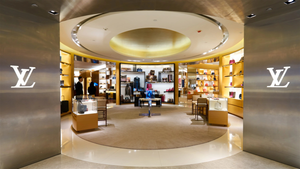
Latin American e-commerce and fintech company MercadoLibre (NASDAQ: MELI) reported Q1 CY2025 results beating Wall Street’s revenue expectations, with sales up 37% year on year to $5.94 billion. Its non-GAAP profit of $9.74 per share was 21.9% above analysts’ consensus estimates.
Is now the time to buy MELI? Find out in our full research report (it’s free).
MercadoLibre (MELI) Q1 CY2025 Highlights:
- Revenue: $5.94 billion vs analyst estimates of $5.49 billion (37% year-on-year growth, 8.1% beat)
- Adjusted EPS: $9.74 vs analyst estimates of $7.99 (21.9% beat)
- Adjusted EBITDA: $935 million vs analyst estimates of $784.9 million (15.8% margin, 19.1% beat)
- Operating Margin: 12.9%, in line with the same quarter last year
- Free Cash Flow Margin: 12.8%, down from 43.2% in the previous quarter
- Unique Active Buyers: 67 million, up 13.5 million year on year
- Market Capitalization: $122.2 billion
StockStory’s Take
MercadoLibre’s management attributed the latest quarter’s financial performance to balanced growth across its core e-commerce and fintech divisions, with notable gains driven by expanding user engagement, enhanced logistics infrastructure, and a focus on user experience improvements. CFO Martin de los Santos highlighted that brand preference metrics reached new highs across major markets, while the credit portfolio grew significantly without a rise in delinquencies. Argentina was called out as a particularly strong contributor, with stabilization in its macroeconomic environment supporting improved margins and higher operating income.
Looking ahead, management emphasized its plans to continue investing in both technology and user acquisition across Latin America, even as it faces rising competition and evolving market dynamics. De los Santos explained, “We do not manage the business to a short-term margin goal; our emphasis is on capturing long-term growth opportunities in commerce and fintech.” Management acknowledged that further investments—especially in logistics, credit products, and promotional activity—could lead to short-term margin pressures, but views these as necessary to sustain the company’s growth trajectory.
Key Insights from Management’s Remarks
Management’s remarks provided context for the quarter’s outperformance, driven by innovation in financial products, improved logistics, and strategic focus on high-growth categories. They outlined how operational efficiencies and market-specific adaptations have begun to pay off, especially in Argentina and across the fintech segment.
- Argentina’s Margin Expansion: Management credited Argentina’s performance to a combination of macroeconomic stabilization, effective cost management, and increased adoption of both e-commerce and fintech services. Improved asset quality and higher transaction volume enabled better fixed cost absorption.
- Supermarket Category Acceleration: The supermarket segment grew faster than any other, enabled by better product selection, enhanced shopping features, and increased share of first-party (1P) inventory, which delivered more favorable unit economics than third-party (3P) sales.
- Fintech User Growth and Engagement: Monthly active users in the fintech division surpassed 64 million, with “yielding account” features and competitive remuneration rates reinforcing user loyalty, particularly in Brazil and Mexico.
- Credit Portfolio Expansion: The credit card business scaled rapidly, with credit quality improving. Management attributed this to refined risk models, a shift toward higher-quality borrowers, and region-specific strategies. Argentina’s credit quality was noted as especially robust, due to historically low private sector debt.
- Investments in Logistics and Branding: Continued investment in logistics infrastructure and the unification of the Mercado Pago brand color scheme were described as steps toward building a single, integrated ecosystem. Management reported that logistics investments remained consistent as a percentage of revenue, supporting ongoing marketplace growth.
Drivers of Future Performance
Management expects future performance to hinge on continued user growth and deeper fintech adoption, while remaining cautious about short-term margin headwinds from ongoing investments and competitive pressures.
- Marketplace Expansion: The company sees significant headroom in e-commerce penetration across Latin America, especially in fast-moving consumer goods (FMCG) and underpenetrated markets such as Mexico.
- Fintech Product Adoption: Management anticipates that expanded digital banking offerings—including high-yield accounts and credit cards—will increase user engagement and cross-sell opportunities, supporting both revenue and margin growth over time.
- Margin Management and Competitive Risks: While the focus remains on growth, management cautioned that margin expansion may be constrained in the near term by logistics investments, credit portfolio scaling, and intensified competition from new entrants, particularly in Brazil and Mexico.
Top Analyst Questions
- Andrew Ruben (Morgan Stanley): Asked about the sustainability of Argentina’s contribution margin, management cited both easier comps and genuine operational improvements, emphasizing cost efficiencies and expanding credit business profitability.
- Irma Sgarz (Goldman Sachs): Inquired about drivers behind first-party (1P) sales growth and margin evolution, with management highlighting technology investments in automatic pricing and selection, and the strategic importance of 1P in supermarkets.
- Marcelo Santos (JPMorgan): Sought updates on logistics expansion, especially in Brazil; management confirmed no major changes to previously announced plans and stressed logistics’ role as a key enabler for future growth.
- Neha Agarwala (HSBC): Asked for details on credit asset quality trends, to which management responded that asset quality remains solid, aided by a move upmarket and particularly strong results in Argentina.
- Craig Maurer (FT Partners): Questioned the evolving competitive environment, especially from new digital banks and Asian e-commerce entrants. Management said competition remains intense but unchanged, and that new entrants often help grow the overall online market.
Catalysts in Upcoming Quarters
In the coming quarters, the StockStory team will monitor (1) the pace of fintech user adoption and whether new product launches like credit cards in Argentina gain traction, (2) the ability of MercadoLibre to maintain margin discipline as it scales logistics and expands into new categories, and (3) competitive dynamics in Mexico and Brazil—particularly the impact of new entrants in digital banking and e-commerce. The rollout of enhanced marketplace features and ongoing improvements in asset quality will also be important markers of execution.
MercadoLibre currently trades at a forward EV/EBITDA ratio of 28.1×. At this valuation, is it a buy or sell post earnings? Find out in our free research report.
Our Favorite Stocks Right Now
Donald Trump’s victory in the 2024 U.S. Presidential Election sent major indices to all-time highs, but stocks have retraced as investors debate the health of the economy and the potential impact of tariffs.
While this leaves much uncertainty around 2025, a few companies are poised for long-term gains regardless of the political or macroeconomic climate, like our Top 5 Strong Momentum Stocks for this week. This is a curated list of our High Quality stocks that have generated a market-beating return of 175% over the last five years.
Stocks that made our list in 2019 include now familiar names such as Nvidia (+2,183% between December 2019 and December 2024) as well as under-the-radar businesses like Sterling Infrastructure (+1,096% five-year return). Find your next big winner with StockStory today.







